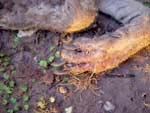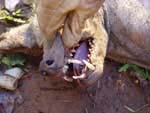

Famous Cases | Historical Tales | Vampires | Zombies
 |  |
Famous Cases | Historical Tales | Vampires | Zombies |
By Lynn Winthrop
Associated Press 10/12/2004
LUFKIN, Texas -- Local animal experts are having a hard time identifying a strange looking animal killed in Angelina County on Friday -- an animal that looks eerily similar to the as yet unidentified "Elmendorf Beast" killed near San Antonio earlier this year.
"What is that?" are the first words out of anyone's mouth when shown photos of the animal, according to Stacy Womack. Womack -- who has more than 20 years experience working at Ellen Trout Zoo and for a local veterinarian -- said she's seen and handled a lot of different animals, but that she's never seen anything like this one.
"It's not a dog," she said. "I'd bet my lottery ticket on that."
 |
The animal was shot and killed shortly before noon Friday after crawling under her mother's house in Pollok. Womack said large dogs in the yard "went nuts" and alerted the family, but would only whine and wouldn't go under the house with the animal. Her brother shot the animal, tied a rope around it and dragged it out from under the house for a closer look, she said. Womack was called to take a photograph of the animal, and possibly help identify it, as well. A live animal, just like the one in the picture, darted across the road in front of her car while she was driving to the scene. When she arrived with her camera and expertise in tow, Womack said she almost couldn't believe what she was looking at.
"It was so necrotic, its tissue was just rotted," Womack said. "It had no hair, a severe overbite and its claws were entirely too long for a dog."
She said the animal's front legs were much smaller than it's hind legs, and that despite it's overall ghoulish appearance, it's extremely long canine teeth were in excellent condition. Also, despite having been shot, there was virtually no blood seeping from the animal's carcass. The animal's ear also "broke like a cookie" when it's head was held up for a photograph, she said
"It's body looked like something that has been dead for a month or so," Womack said. "Like I said, I've worked in the veterinary field for more than 20 years and I've never seen anything that bad."
The animal was male and weighed between 15 and 20 pounds, she said. The identical animal that sprinted across the road ran with it's head down and it's tail between it's legs, according to Womack, but wasn't tall enough to be a coyote or a wolf. She said the live animal is probably the dead one's mate.
"I would just like to see somebody go out there and try to trap the other one," Womack said. "Because it's in misery, too, and what if it gets into the population?"
 |
"I just want people to be aware that things like this happen," Womack said. "If it's not the mange, it's something that doesn't need to be in the environment."
C.R. Shilling, of the West Loop Animal Clinic in Lufkin said that after seeing pictures of the animal -- and stressing that his determination is "pure speculation" -- he believes the animal is probably a coyote. The animal likely suffers from demodex mange, he said, and possibly a secondary skin infection or even a congenital skin defect, as well.
"That's just a congenital defect," Shilling said when asked about the animal's unusual jaw configuration. "We'll even get dogs like that in here."
Shilling said that without seeing the animal itself, it's hard to make an exact determination of what the animal might be. The possibility of it being a dog/coyote mix would be "unusual, but possible," he said.
"It appears to be an extremely undernourished dog," Ellen Trout Zoo Director Gordon Henley said after being e-mailed several photos of the animal. "Wild animals don't typically wind up like that, but undernourished, neglected, domestic animals do."
After enlarging one of the photos and conferring with the zoo's veterinarian, Henley said he feels the animal's mangy, crusty skin could be a result of either neglect or living in the wild. Undernourishment or a congenital deformity could have caused the animal's gross overbite, he said.
"I think what we've got here is a poor, suffering, undernourished and possibly abused canid," Henley said. "Possibly a coyote, but more likely a dog."
 |
Speculation in the area as to what type of the animal the rancher killed has varied from simple to mystical. Some say it's a wild Mexican hairless dog, and other than the skin condition and jaw, pictures of the breed do bear a resemblance. Others believe it's the mythical chupacabra -- or "goat sucker" -- an animal Mexican folklorists say stalks rural areas killing livestock. One area hunting guide even believed the animal might be a muntjac, a small antelope-type animal imported into the state by ranchers, according to the station's online reports. Muntjac are herbivores, but do have upper canine teeth that are elongated into "tusks" that curve outward from the lips. Muntjac are also called "barking deer" for a sound they'll emit to warn others of predators. Like most deer, however, the Muntjac have split hoofs instead of paws, and certainly don't have long, rat-like tails.
A San Antonio Zoo mammal expert told WOAI-TV the animal is clearly a member of the canine family, and could possibly be a mix between a dog and a coyote. The expert also said the animal was clearly suffering from some sort of skin ailment, and may also have a congenital deformity of some sort.
Sightings of similar animals have been reported across the country, from California to Maryland.